Betty, Girl Engineer
A Look Back as FHWA Celebrates National Women's Month
by Richard Weingroff
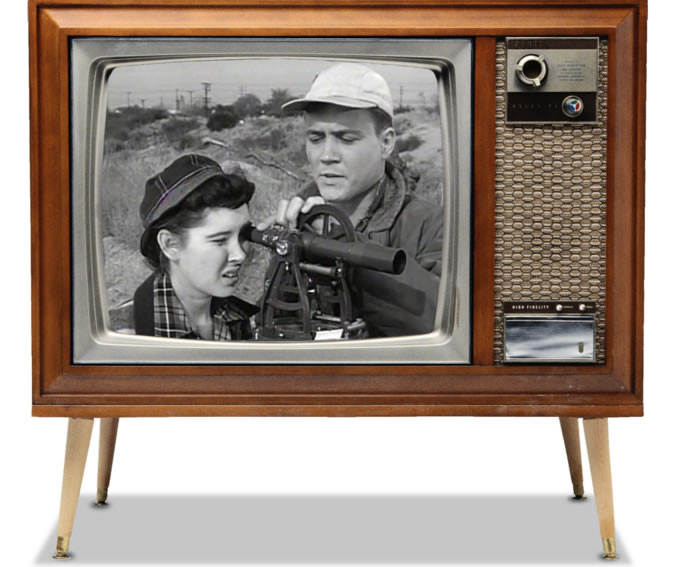
I grew up in the 1950s with television as a constant presence once my father finally bought a black and white TV for our home in Baltimore. On the one hand, there was my family – father, mother, an older brother, a younger sister, and me, the middle kid – with the usual pleasures and problems of growing up in the 1950s. On the other hand, there were the many TV sitcom families I knew so well. They all had problems, too, but not only were they funnier than ours, they were solved within 30 minutes and forgotten by the next episode. (In contrast, my parents seemed to remember every mistake I made.)
Maybe the TV families weren’t real, but I never thought, “these shows give boys and girls bad ideas about their roles in life.” On April 11, 1956, TV viewers had a chance to see what happens when a girl decides to pursue a gender-defying career.
Betty, Girl Engineer
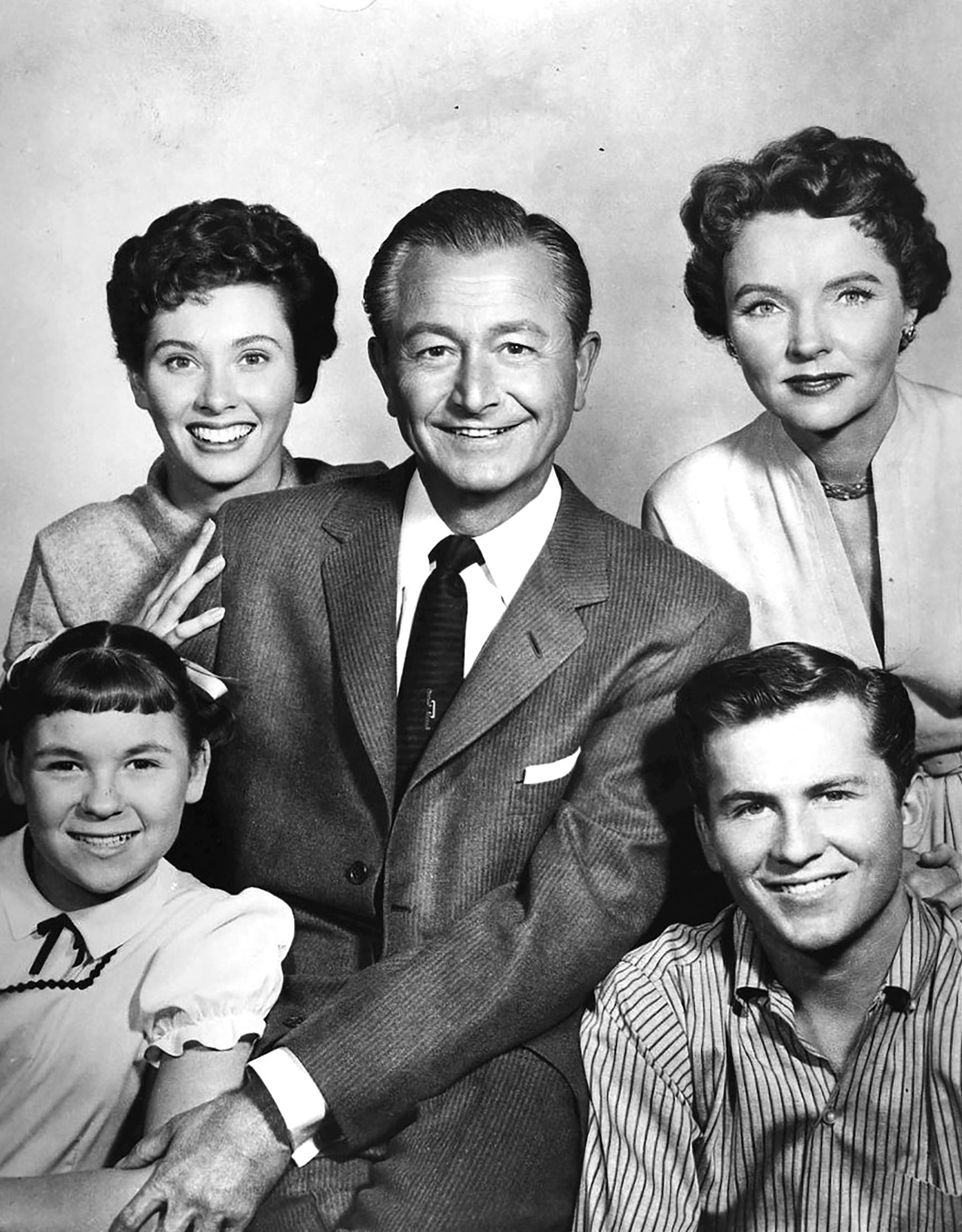
Father Knows Best Cast - The Andersons. Pictured are top from left (real names): Elinor Donahue, Robert Young, Jane Wyatt – bottom: Lauren Chapin, Billy Gray
In the 1950s, gender roles were stereotypically defined. Women constituted less than 40 percent of the Nation’s workforce, often occupying what were considered traditional women’s jobs, such as nurses, teachers, secretaries, and waitresses. Girls in school took “home economics” while boys took a vocational class such as wood shop (where I built a small end piece that proved to be the last successful carpentry work of my life). Girls played with dolls, boys with toy guns. Boys expected to go to work when they grew up, while girls were supposed to get married, have babies, and become housewives – just like on most TV shows of the era, with exceptions such as Ann Sothern in “Private Secretary” (1953-1957) and Eve Arden as a teacher in “Our Miss Brooks” (1952-1956).
I was 8 years old when Father Knows Best debuted on October 3, 1954, in a terrible time-slot (Sunday on CBS at 10 p.m.). The show starred Robert Young as Jim Anderson, a salesman and manager of the General Insurance Company in a town called Springfield that didn’t seem to be in any particular State. Jane Wyatt played Anderson’s spouse Margaret, a housewife. The Andersons had three children: 17-year old Betty “Princess” Anderson (Elinor Donahue), 14-year old James “Bud” Anderson, Jr. (Billy Gray), and 9-year old Kathy “Kitten” Anderson (Lauren Chapin). The show, which switched to NBC in 1955 and a more congenial time-slot on Wednesday at 8:30, ran for 203 episodes through 1960.
The show was not based on the slapstick antics of “I Love Lucy” and many other sitcoms of the day. The New York Times said of the father, “he is one video papa who is not a king-sized dope but a rational soul who approaches the problems of adolescence with humor and understanding.” As a later Times reviewer observed, Margaret Anderson was different from other sitcom wives and mothers:
Mother conducts herself with appropriate dignity. She knows how to keep a budget and attend to other household duties without fluttering. She does not forget to turn off the oven when the cake is baked.
The show took place in an idealized world where the issues on the front pages of newspapers throughout the country never quite reached Springfield.
In episode 30 of season 2, broadcast on April 11, 1956, the role of women and men was the subject. While Margaret showed Jim a pretty new dress purchased for Betty, Betty was in line to sign up for a Spring Break week of practical work experience in her chosen career field as part of her school’s Vocation Guidance Course. One boy wanted to be an electrical engineer. The girl in front of Betty told the counselor she wanted to be a movie usher so she could watch movies for free. He gave her an assignment card to a business where she could get secretarial experience. “That would be best,” he told her.
Betty told the counselor, with enthusiastic certainty, she’d been “sort of flopping around, floundering,” but now after the vocational speeches she’d heard, “I feel as though my whole future’s been crystallized.” She wanted to be an engineer. The boy behind Betty said, “You must be kidding. You don’t mean that.” When she assured him she did mean it, he said, “But you’re a girl.” She replied, “Aren’t girls people?” She walked off with her assignment card, while the boy and the counselor looked puzzled by her choice.
After school, Betty rushed home to tell her family of her important decision. She said that while the school tried to mold the students’ “putty like little brains into the channels they were intended for,” she’d found her niche. “I know my bent.” Before revealing the decision, Betty cautioned her parents that when she told them, there was “no need for anyone to go off the deep end.” She was going to be an engineer. No one took her seriously. Margaret explained, “Certainly not, you’re joking.” Betty replied, “Oh, am I?” She had signed up for a county surveying crew.
While Betty went upstairs, Margaret turned to her husband. “Jim, she can’t possibly mean that.” He assured her that Betty was quite serious. “For the moment, at least. But I’d say after half a day of tramping through the dirt and lugging surveying instruments, she’ll be ready to take up some nice vocation, like crocheting.”
Betty heard his comment, but assured them, “I will not give this up after half a day.” Girls, after all, were entering “all kinds of professions now, and why shouldn’t they?”
When Jim said, “I’m surprised they’d take a girl,” Betty explained that she had signed up as “B.J. Anderson,” so they wouldn’t know she was a girl.
She did well in math and her tests showed she had a strong aptitude for it. Sure, Jim said, but just wait until she gets into trigonometry and calculus. Engineering schools, he added, were very selective. Betty asked, “So, you think I should give up a thing just because it’s difficult?” Squirming in his chair, he replied, “Uh, no no, I just mean that ...”
Margaret interrupted. “This isn’t the life for you,” describing Betty’s interest in music, ballet, and literature. Betty replied, “there’s music and poetry in a fine bridge.” There was, she added, more to life than “romance and all that gonk.” Moreover, engineers were in demand and the work paid very well.
In the morning, Betty was dressing when Kathy came in. She thought Betty was going to be a train engineer. Betty impatiently explained that she’d be the type that designed bridges, and rushed downstairs for breakfast. Kathy remarked to herself, “Boy, there’s a mixed-up kid.”
Margaret also was confused. “I feel as though we don’t have a daughter anymore. I’d hardly know what kind of towels to hang in her bathroom. His or hers.”
Betty went to work with a crew that was run by a handsome college student named Doyle Hobbs. He was surprised to discover that B.J. was a girl, but took her with him to the job site where his crew was gathering survey data to turn over to the design engineer of the road.
Doyle took B.J. with him to the “transit or gun,” which they would use to lay out a straight line. As he provided each bit of information, he added a question. For example, he showed her how to adjust the transit to see the crosshairs clearly, adding “You mad at your boyfriend? Don’t you like your home?” They must, he explained, “Not get off the track like, say, a good-looking kid fooling around with surveying when she ought to be home.” She replied that she signed up for vocational experience, “not psychiatric counseling.”
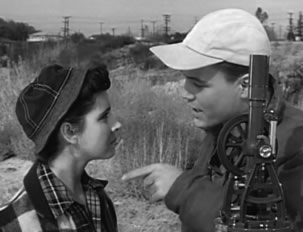
"Why don’t you go home where little girls belong ... You’re a girl and a girl has the obligation to be one."
At one point, he asked, “Why don’t you go home where little girls belong.” Betty replied, “I’m not a little girl.” But Doyle summarized, “You’re a girl and a girl has the obligation to be one.” A woman’s place was in the home, “not knocking around with a transit and a couple of chainmen.” A man has his place, and a woman has hers. She replied, sarcastically, “You have everything all figured out, don’t you?” Doyle told her, no, he didn’t figure it out. It was figured out “long before I came along.”
He was going to show her how to set up a plumb bob to establish a vertical reference line. However, while he wasn’t looking, Betty had stormed off and walked home.
Back home, Margaret tried to comfort Betty, whose feet had blisters from the long walk. She hadn’t called her father to pick her up after his “cracks about me quitting by noon.” Margaret soothed her, saying, “Maybe it’s all for the best.” No, Betty replied, it wasn’t. “I’ll still make good.” Margaret tried to interest Betty in the new dress, but all she could do was mock Doyle, calling him a “little pipsqueak,” bossing around much older men. Margaret asked what he looks like. Betty thought, then came up with a description. He looks like a “Plumb Bob.”
When Jim came home and found out what had happened, he was upset by Hobbs’s high-handed treatment of Betty. He wished he would have a chance to tell Doyle just what he thought of him.
Later, while Betty was slouched on the sofa reading Introduction to Engineering, there was a knock on the front door. Bud answered. It was Doyle, dressed in a suit and tie, with a box of chocolate covered cherries. Betty didn’t want to see him, so she hid in the dining room. Bud let Doyle in, then was surprised Betty wasn’t still on the sofa.
Jim decided to take advantage of the opportunity to give Doyle a piece of his mind. Instead, Doyle asked Jim “What is your opinion. I mean about a girl taking up a man’s job.” Before Jim could reply, Doyle continued, “It just don’t seem right. Not that she couldn’t be an engineer. “She might be a darned good one. But think what a dirty trick that might be on some guy.”
“What guy?” Jim asked. “Any guy,” Doyle told him, “maybe some young engineer. Some guy who works hard all day in the dust and heat. Why does he do it?” he asked, not waiting for an answer. “So that when the day’s over, he can come home to some nice, pretty wife. That’s what makes working all day in the dust and heat worthwhile. That’s why you have bridges and roads and everything we’ve built. To make a nice place for the guys and their wives and kids to live in. But if the nice pretty girls are gonna be out there in the dust and heat too, who are the guys gonna come home to?”
Jim tried to speak, but Doyle continued that “the way I look at girls, I like to think of somebody in a pretty dress, somebody you can give a box of candy to, not a stack of grade stakes and a sledgehammer.” Doyle seemed genuinely confused because as an engineer, he was used to getting his calculations right, but with Betty, “for the first time, my calculations were off. Way off.”
Jim, who hadn’t been able to get a word in, said that Doyle didn’t have to convince him, and walked him to the dining room where Betty had been hiding. But she had disappeared. Just as Doyle was about to leave, Betty came downstairs. She had put on her new dress and acted friendly. Doyle said, “This is more like it. Yeah.” As Jim and Margaret left them alone, Betty mocked Doyle’s way of providing instructions on the assumption she didn’t know how to use the equipment. “See this instrument, kid? This is a telephone ... Know how to use it? No, you don’t know how. Okay, you dial these little numbers, see, D.H.? And if a girl answers, you say, ‘May I have a date for Saturday night?” He asked, “and what does she say?” Betty replied “mm-hmm,” meaning yes. She notices the box of candy, asking, “Chocolate-covered plumb bobs? Mmm!”
A happy ending, indeed, 1950s style!
In true sitcom problem solving mode, by the next episode, Betty was dating another boy. Doyle was forgotten. (The actor who played him, Roger Smith, would soon be cast as Jeff Spencer on the new detective show, 77 Sunset Strip, playing the character for five of the show’s 6-year run from 1958 to 1964. He later married singer-actress Ann-Margret and managed her career.)
When “Betty, Girl Engineer” aired on April 11, 1956, most viewers did not see anything to be concerned about. The stereotyped roles were common in their time, and did not seem unusual to viewers who watched dozens of TV shows every week with similar male-female divides.
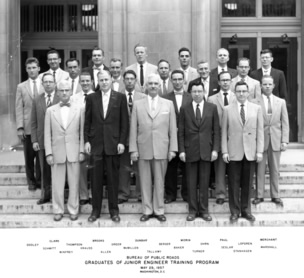
If Betty Anderson had become an engineer, and joined BPR, her Junior Engineer Training Program would have looked more or less like the graduating class of 1957. The first woman wouldn’t enter the training program until 1964. The front row (left to right) shows Robley Winfrey, Chief of the Personnel & Training Division; Deputy Commissioner James C. Allen; Federal Highway Administrator Bertram D. Tallamy; Deputy Commissioner & Chief Engineer Francis C. “Frank” Turner; and William H. Stanhagen of the Training Branch.
The Society of Women Engineers (SWE), formed in 1950, was an exception. A display in SWE’s 65th anniversary publication headlined a brief reference to the episode as “Father Does Not Know Best.” It reprinted an item by Emma C. Barth from the newsletter of SWE’s Pacific Northwest Section calling the episode “detrimental, to say the least, to engineering as a profession for women.” She wrote, “Programs such as this could easily set us back many years by adversely influencing young women, who have the necessary ability, as well as their parents.” Barth encouraged other SWE sections to join her in writing to NBC, its local affiliates, the sponsor (Scott Paper Company), and the show’s producers to let them know that, “This one program, seen by millions, may have undone all the progress in professional guidance of which we have been so proud.” She advised her readers that, “If there is sufficient protest from the Society of Women Engineers, there is just a possibility that a public apology might result.”
Just two and a half months after “Betty, Girl Engineer” aired, President Dwight D. Eisenhower signed the Federal-Aid Highway Act of 1956 on June 29, 1956, launching construction of the Interstate System and presenting a new challenge that many young engineers would accept – all of them male during the early years.
Betty did not become an engineer. During the final season, in “Betty’s Career Problem,” she graduated from college near the top of her class and applied for a merchandising job with the local department store. There was one problem, as the manager explained during her job interview. “We found that training pretty girls for career jobs doesn’t pay off.” Betty thanked him for the compliment, but assured him she was serious about the opportunity. He continued, “But you pretty girls usually end up at the altar about the time we’re ready to put you behind a desk.” He assured her it was nothing personal. He was just speaking from experience. Nevertheless, by the time of a 1977 reunion show starring the original cast, Betty was a widow living in Chicago with two young daughters. She supported her family as a buyer for a department store.
For those who wonder how an ambitious, bright, determined, and eager teenage girl such as Betty might have been discouraged in 1956 from being an engineer, the episode can be found online and along with the entire series is available on Peacock.
Beverly, Girl Engineer
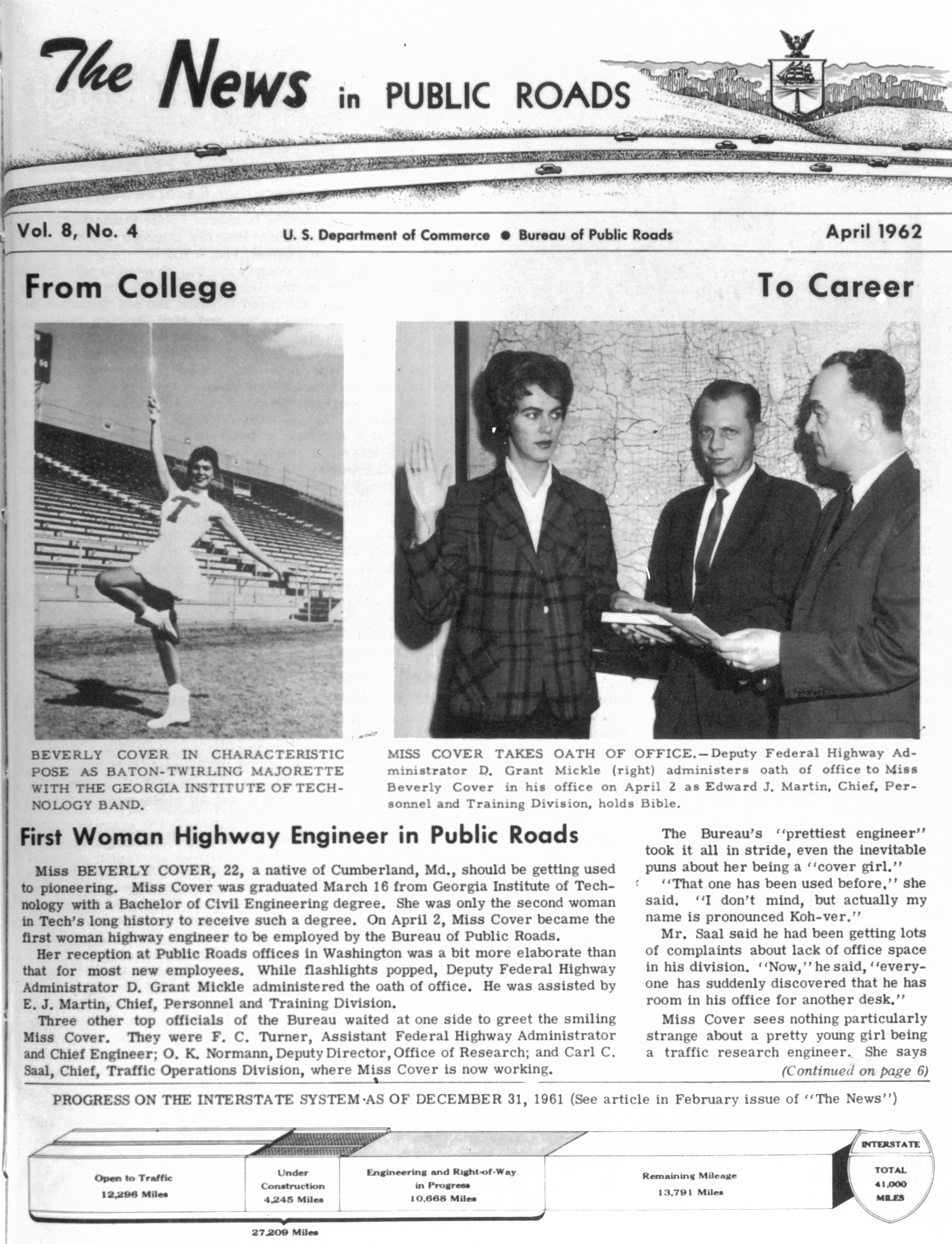
The U.S. Bureau of Public Roads greeted its first woman highway engineer with a cover feature in The News in Public Roads. Deputy Administrator D. Grant Mickle (right) administered the oath of office while Edward J. Martin, Chief, Personnel and Training Division, held the Bible for the agency’s "prettiest engineer."
In the 1950s, the U.S. Bureau of Public Roads (BPR) was guided by a white male engineering force. In a 1952 college recruiting brochure titled Opportunities in the Bureau of Public Roads for Young Engineers, the text used exclusively male pronouns.
We do not know if Beverly Ann Cover saw “Betty, Girl Engineer.” If she did, she would have anticipated the Plumb Bob-type comments that greeted her on April 2, 1962, when she became the first woman employed by BPR as a full-time highway engineer. A 22-year old native of Cumberland, Maryland, Miss Cover had graduated a month earlier from Georgia Institute of Technology. (The News in Public Roads, BPR’s in-house newsletter, always listed the marital status of female employees.) She had studied highways and traffic engineering, and had been a “baton-twirling majorette” with the band for 3 years. The News gave her swearing in ceremony front page coverage, along with a photo of her “in characteristic pose” as a majorette.
She would work for Carl C. Saal, Chief of the Traffic Operations Division, at the Langley Research Station (now part of the Turner-Fairbank Highway Research Center). Saal, in Plumb Bob mode, said he had been getting lots of complaints about a lack of office space. But now “everyone has suddenly discovered that he has room in his office for another desk.” The News explained that BPR’s “prettiest engineer” was comfortable with such comments, including jokes about her being a “cover girl.” She said, “That one has been used before. I don’t mind, but actually my name is pronounced Koh-ver.”
Her initial BPR duties involved traffic performance, highway capacity, and driver-behavior studies. Her work included field studies using BPR’s “Traffic Analyzer,” which was designed to collect data and traffic-flow characteristics electronically on different types of highways.
On June 16, 1962, she married Charles Frederick Norris of Cumberland. She would thereafter be known in The News as Mrs. Beverly Cover Norris, who played center field for BPR’s girls softball team.
The October 1963 issue of The News featured a cover article on “Womanpower in Public Roads.” It began, “Overseeing the construction of vast highway systems and building national parkways and forest roads is essentially man’s work.” However, 23 percent of BPR’s positions were held by women in 52 occupation series:
Women are employed in such diverse occupations as engineering, drafting, illustrating, photography, writing and editing, library science, and the legal profession. They are represented in administrative, management, and personnel occupations.
About 35 percent of the other women were engaged in clerical work “and carry much of the paperwork burden necessary to conduct a complex worldwide program.” The article added, “Many women capably fill the supervisory positions, several have entered the new occupation of digital computer programing, and recently a young woman was heralded as Public Roads first woman highway engineer.” In short, the reference to “engineering” meant Mrs. Norris.
Things, clearly, were looking up for women in BPR. Nevertheless, the same issue contained photographs of men receiving awards, signing concurrent billing and auditing agreements, attending the Hydraulic Engineers Workshop, bagging a bighorn antelope, and retiring, with one wife present. The issue also included a photograph of 21-year old Miss Janet Ann King, a clerk-stenographer in the West Virginia Division Office, who was crowned “Alpha Iota Queen” during a convention of the Alpha Iota International Honorary Sorority in Cleveland. “Alpha Iota is primarily designed to promote a spirit of fellowship among young women business students.”
In 1964, Beverly Cover Norris resigned to become a housewife and mother (eventually of six children). In a 1979 article in the Georgia Tech Alumni Magazine, she wrote that after leaving BPR, she remained at home for several years before going into business with her husband in Cumberland. Buchanan and Norris Builders specialized in custom homes and swimming pools. She designed the homes and often visited the sites during construction. They also owned a retail ski shop that she ran during the winter.
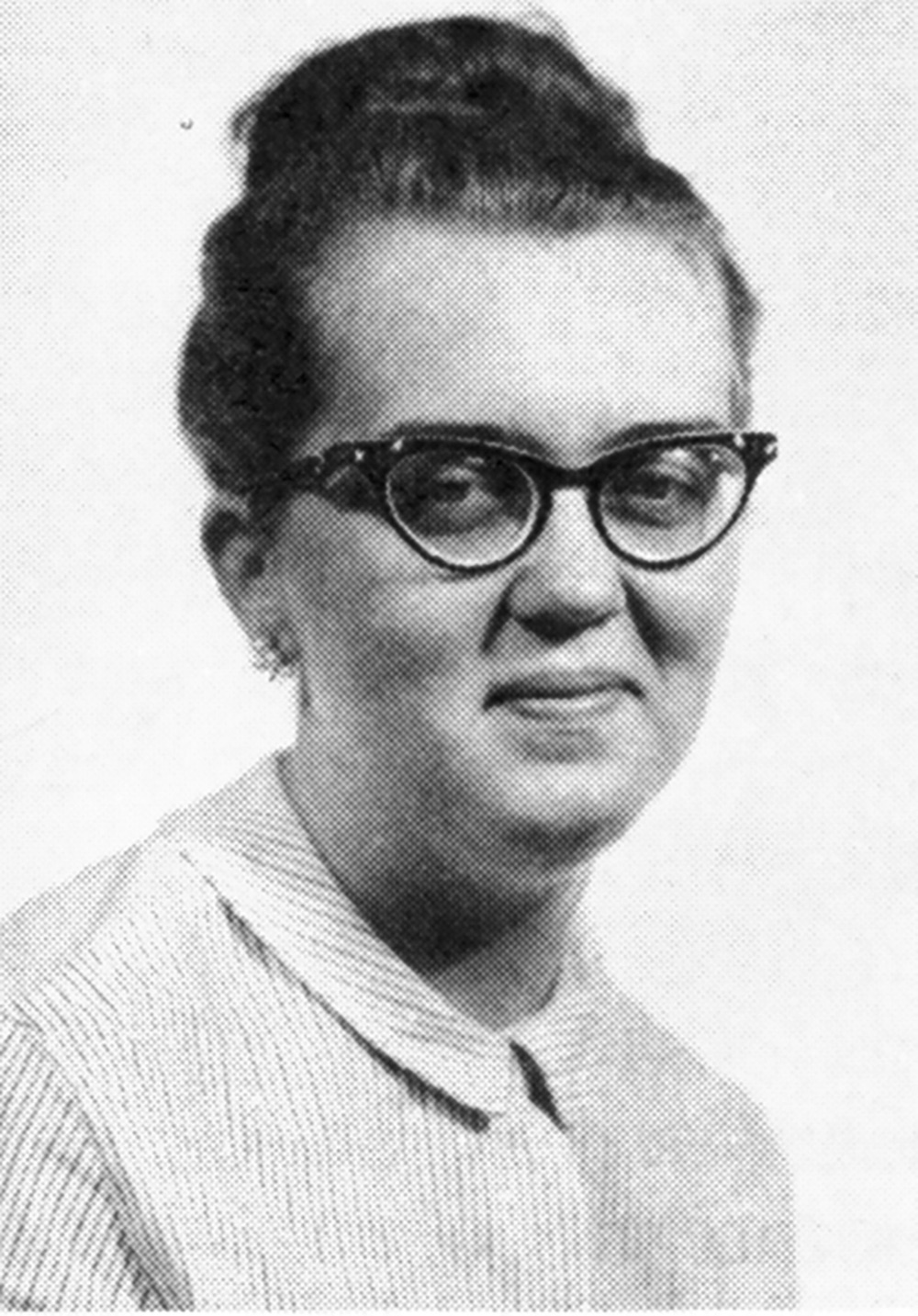
Karen M. Porter, a 22 year old graduate of Merrimack College in Massachusetts, was the second woman engineer to join the agency. And not a moment too soon, according to an article in The News in Public Roads. "When it comes to women engineers, the Bureau of Public Roads is managing to hold its own, having had one report for duty within a week after it lost its only other woman highway engineer." That other woman, Beverly Cover, left "to become full-time house-wife and mother." Porter was assigned to the Automatic Data Processing Division, where was trained as a systems analyst.
She said she enjoyed her time at Georgia Tech, but “a lot of things were closed to women. We weren’t allowed to earn degrees in several disciplines, and many campus organizations would not admit women. My freshman year, women weren’t even allowed to eat in campus dining halls.” The student body (1959-1962) consisted of 6,000 men and 39 women. She explained, “I feel like we were pioneers.” Had Betty Anderson pursued her niche to become an engineer, she probably would have had similar experiences.
According to The News in Public Roads, BPR conveniently hired its second woman highway engineer a week after Norris left the agency, to keep the total at one:
Miss Karen M. Porter, 22, who graduated from Merrimack College in North Andover, Mass., with a bachelor of science degree in civil engineering, recently entered on duty with Public Roads. She has been assigned to the Automatic Data Processing Division, where she is being trained to become a systems analyst. This will enable her to apply her engineering know-how in the electronic processing of engineering data. As a systems analyst, her tasks will include working with hydraulics engineers to develop computer programs to design highway culverts; with bridge engineers in developing programs to compute the most economical structures that can be built under given conditions; and with planners in the utilization of data obtained by interviews to forecast future traffic volumes and transportation.
By 1964, BPR’s recruitment brochure explained, in all caps, that “ALL QUALIFIED APPLICANTS AND EMPLOYEES WILL RECEIVE CONSIDERATION WITHOUT REGARD TO RACE, CREED, COLOR, NATIONAL ORIGIN, MARITAL STATUS, SEX, PHYSICAL HANDICAP, OR LAWFUL POLITICAL AFFILIATION.”
Although women could apply, pronouns remained male.
Neither Beverly Cover Norris nor Karen Porter had graduated from BPR’s 3-year Highway Engineer Training Program; both were hired out of college. The first woman to enter the training program was Miss Judith A. Carlson, a 25-year old from Hancock, Michigan, who reported for duty in the New Jersey Division Office on October 6, 1964, for her initial 6-month assignment. The Associated Press began a widely reprinted article about her: “The Federal Government boasts some real live curves in its roadbuilding program – a shapely blonde who may wind up in charge of a construction crew this summer.” The AP wire photo used with the article depicted Carlson smiling over the highway scene from behind a surveyor’s transit, just as Betty Anderson tried to do a decade earlier.
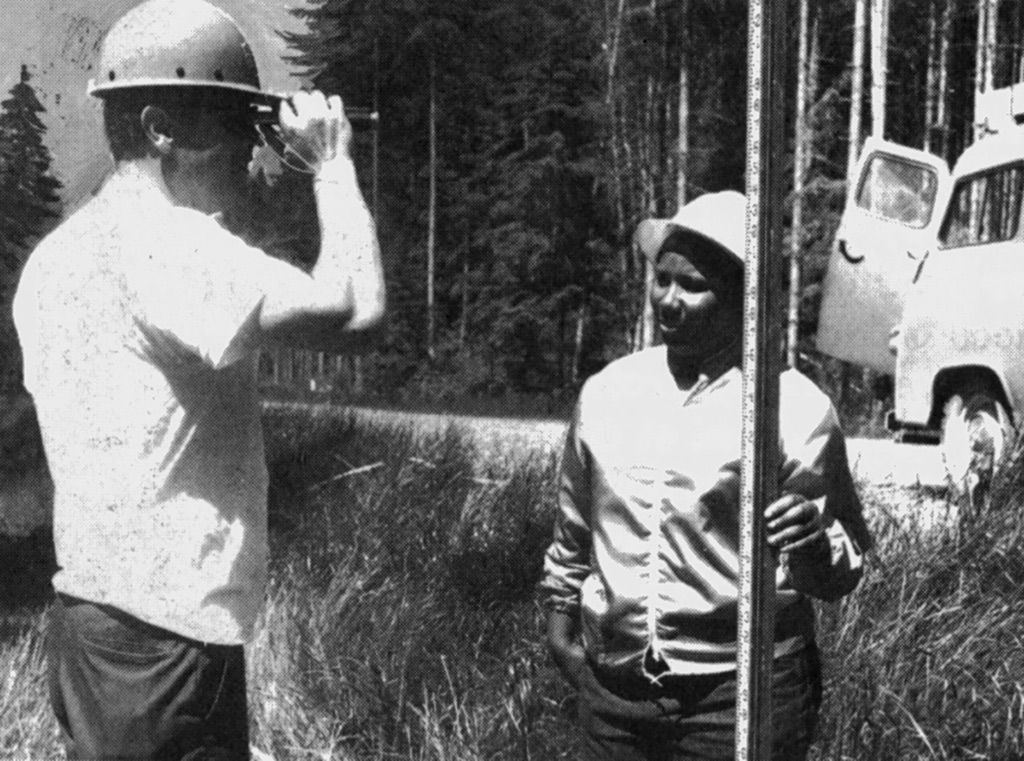
Mary L. Anderson was the first woman to graduate from the Highway Engineer Training Program. As part of her training in 1970, Anderson worked on the Heart o' the Hills project in Port Angeles, Washington. In the photo, Jim Bailey, project engineer, delivered a few tips on use of the level rod. A woman engineer was sufficiently unique that members of the crew weren't sure about the idea. One said, "there are many jobs a woman can handle," but he thought that field work on a road crew is "no job for a woman." Anderson, who obviously didn't agree, was enjoying the field work, but admitted that "the transit is pretty heavy."
Although Carlson was the first to enter the training program, she was not the first to graduate. Mary L. Anderson, an African-American who graduated from Prairie View A&M University in Texas with a BS in Civil Engineering, was the first. When she was offered the opportunity, she wasn’t sure. “I guess it was the chance to travel and the possibility of pursuing an advanced degree if I wanted it that finally sold me on the program.” Her three older brothers also had received engineering degrees from the university, but went into mechanical, electrical, and aerospace engineering. She joked that she went into civil engineering “to defend myself.”
Changing Times
In June 1950, 60 women met at The Cooper’s Union Surveying Camp in Ringwood, New Jersey, to found SWE. Its 65th anniversary publication in 2015 explained, “SWE challenged public stereotypes concerning women’s roles and technical abilities.”
Today, SWE has 42,000 members, but notes that 30 percent “of women who have left the engineering profession cite organizational climate as the reason.” An article in SWE’s magazine on State of Women in Engineering 2020, described how women engineers experience the “insidious discriminatory treatment” that has no legal consequences. “Examples include male bosses who minimize women’s accomplishments, interrupt when women talk, create barriers to opportunities and mentorships, omit women from high-impact project teams, and subject women to harsher scrutiny than their male colleagues ... In fact, a lingo has even sprouted up to identify the problem with phrases such as women being ‘man-terrupted’ while they’re talking at a meeting, and having an idea ‘bro-priated’ (‘bro’ being shorthand for men).” To borrow language from “Betty, Girl Engineer,” they were Plumb Bobbed.
Today, engineering remains the largest percentage of FHWA’s workforce, around 35 percent of about 2,700 employees. FHWA had 964 engineers at the end of 2020, including 216 women (22.4 percent). An additional 91 employees are classified as engineering/surveying technicians, including 6 women (6.6 percent). In addition, women fill many of FHWA’s leadership positions, including Associate Administrators, Office Directors, Division Administrators, Directors of Field Services and Federal Lands Highway Divisions, and recent Administrators and Deputy Administrators, such as Stephanie Pollack, today’s Acting Administrator.
I don’t recall watching “Betty, Girl Engineer” at the time, but I would have been 9 years old when NBC broadcast it. I hope 9-year old Ricky will be forgiven if on April 11, 1956, he didn’t know that Doyle Hobbs was on the wrong side of history.

